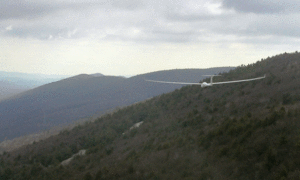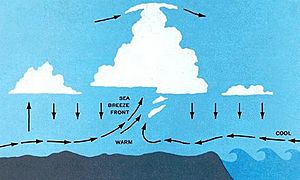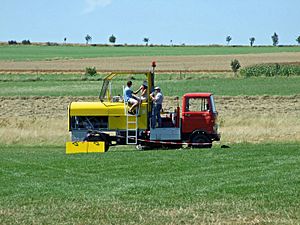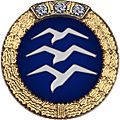Gliding facts for kids
Gliding is when something, like a special airplane or even some animals, moves through the air without using an engine or flapping wings. Gliders use their wings or membranes to slow down how fast they fall. They can stay in the air for a long time by finding and using rising air. This is called 'soaring', and it's also the name of the sport of gliding.
Air can rise when the ground heats it up, or when it hits mountains and is pushed upwards. Thanks to better airplane designs (called aerodynamics), improved tools, and a better understanding of weather, gliders can now fly very far and fast. The current world record for distance is over 3,000 kilometers (about 1,860 miles)!
Contents
Sport Gliding: Flying Without an Engine
How Gliders Stay Up: Soaring High

Glider pilots can stay in the air for many hours. They do this by flying in air that is rising as fast as, or even faster than, their glider is sinking. This helps them gain height. The most common ways gliders find rising air are:
- Thermals: These are bubbles of warm air rising from the ground.
- Ridge lift: This happens when wind blows against a hill and is forced upwards.
- Wave lift: These are like invisible waves in the atmosphere, similar to ripples on water.
Ridge lift usually lets pilots climb about 600 meters (2,000 feet) above the ground. Thermals can allow climbs over 3,000 meters (10,000 feet) in flat areas, and much higher near mountains. Wave lift has even allowed a glider to reach an amazing height of 15,447 meters (50,671 feet)! In some places, gliders can fly into clouds, but in many countries, pilots must stop climbing before they reach the cloud base.
Finding Thermals: Warm Air Bubbles
Thermals are currents of rising air. They form when the sun heats the ground, which then warms the air above it. If the air has enough moisture, the water vapor will cool and turn into tiny water droplets, forming cumulus clouds.
When a pilot finds a thermal, they usually fly in circles. This keeps the glider inside the rising air, helping it gain altitude. After climbing high enough, the pilot flies to the next thermal, moving closer to their goal. This circling is called "thermalling." Gliders can climb several meters per second in good thermals. Sometimes, thermals line up due to wind or land features, creating "cloud streets." Pilots can fly straight along these lines, climbing continuously.
If the air is dry, or if a layer of warm air (an inversion) stops the warm air from rising high enough, cumulus clouds won't form. Without clouds or dust devils to show where thermals are, pilots must use their skills and a special tool called a variometer. This tool quickly shows if the glider is climbing or sinking. Thermals are often found over towns, freshly plowed fields, and asphalt roads. However, they can be hard to spot from the ground. Sometimes, power station exhaust or fires can also create thermals.
Because thermals need warm, rising air, they are best from spring to late summer in most places. In winter, the sun's heat is weaker, so thermals are not as strong. However, ridge and wave lift can still be used during winter.
Riding the Wind: Ridge Lift
A ridge soaring pilot uses air that is pushed up the sides of hills. If the slopes also face the sun, thermals can add to this lift. In places with a steady wind, ridge lift can allow pilots to stay in the air for a very long time. However, records for how long a glider can stay up are no longer officially recognized because of the danger of pilots getting too tired.
Surfing Air Waves: Wave Lift
The powerful rising and sinking air in mountain waves was first discovered by a glider pilot named Wolf Hirth in 1933. Gliders can sometimes climb to very high altitudes in these waves. Pilots need to use extra oxygen to avoid getting sick from the thin air.
These waves are often marked by long, still lenticular (lens-shaped) clouds. These clouds lie across the direction of the wind. Mountain waves were used to set the current altitude record of 15,450 meters (50,699 feet) on August 29, 2006, over El Calafate, Argentina. The pilots, Steve Fossett and Einar Enevoldson, wore special pressure suits for this flight. The current world distance record of 3,008 kilometers (1,869 miles) by Klaus Ohlmann on 21 January 2003 was also flown using mountain waves in South America.
A rare type of wave is called the Morning Glory. This is a roll cloud that creates strong lift. Pilots near Australia's Gulf of Carpentaria use it in springtime.
Other Ways to Get Lift
Areas where two different air masses meet are called convergence zones. These can happen with sea breezes or in desert areas. In a sea-breeze front, cool air from the sea meets warmer air from the land. This creates a boundary like a small cold front. Glider pilots can gain height by flying along this boundary, just like flying along a ridge. Convergence zones can stretch for long distances, allowing pilots to fly almost straight while climbing.
Glider pilots have also used a technique called "dynamic soaring." This is where a glider gains speed by repeatedly crossing the boundary between air masses that are moving at different speeds. However, these areas of strong "wind gradient" are usually too close to the ground to be used safely by gliders.
How Gliders Take Off: Launch Methods
Gliders don't have engines, so they need help to get into the air. Pilots who want to use different launch methods must practice each one regularly. In some countries, the rules for pilot licenses are different for aerotows and ground launches because the techniques are very different.
Aerotowing: Pulled by Another Plane
Aerotows usually use small, single-engine planes to pull the glider. Sometimes, motor gliders (gliders with small engines) can also tow other gliders. The tow-plane takes the glider to the right height and place. Then, the glider pilot releases the rope. A weak link is often put in the rope. This makes sure that sudden pulls don't damage the tow-plane's airframe.
During the aerotow, the glider pilot keeps the glider in one of two positions behind the tow-plane. They can fly in the "low tow" position, just below the air disturbed by the tow-plane (called its wake). Or, they can fly in the "high tow" position, just above the wake. In Australia, pilots usually fly in low tow. In the United States and Europe, high tow is more common. One way to aerotow is to attach two gliders to one tow-plane. One glider uses a short rope for high tow, and the other uses a long rope for low tow.
Winch-Launching: Pulled by a Cable
Gliders are often launched using a powerful winch on the ground. This winch is usually mounted on a heavy vehicle. This method is very popular at many gliding clubs in Europe, often used along with aerotowing. The winch usually has a large diesel engine, but some use hydraulic fluid engines or electric motors.
The winch pulls in a long cable, about 1,000 to 1,600 meters (3,000 to 5,500 feet) long. The cable is made of steel wire or a strong synthetic fiber and is attached to the glider. The glider has a short, steep ride into the air. The cable is released when the glider reaches a height of about 400 to 700 meters (1,300 to 2,200 feet).
The main benefit of a winch launch is that it costs less. However, the launch height is usually lower than an aerotow. This means flights might be shorter unless the pilot can quickly find rising air within a few minutes of releasing the cable. There is a small risk of the cable breaking during this type of launch, but pilots are trained to handle it safely.
Auto-Tow: Pulled by a Vehicle
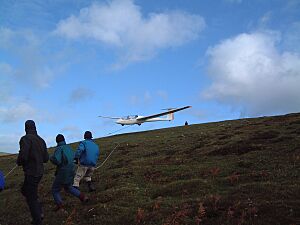
Another launch method, called "autotow," is not as common today. This method needs a hard surface, a powerful vehicle, and a long steel cable. After gently taking up the slack in the cable, the driver of the vehicle accelerates quickly. The glider then rises like a kite. It can reach up to 400 meters (1,300 feet) if there's a good headwind and a runway of 1.5 kilometers (1 mile) or more. This method has also been used on dry lakebeds in deserts.
A different version of this is the "reverse pulley" method. In this case, the truck drives towards the glider it is launching. The cable passes around a pulley at the far end of the airfield. This creates a similar effect to a winch launch.
Bungee Launch: The Old-Fashioned Way
Bungee launching was widely used when gliding first started. Sometimes, gliders are still launched this way from the top of a gently sloping hill into a strong breeze. They use a thick, multi-stranded rubber band, or "bungee." For this launch, the glider's main wheel rests in a small concrete dip. The hook normally used for winch-launching is attached to the middle of the bungee.
Then, three or four people pull each end of the bungee. One group runs slightly to the left, the other to the right. Once the bungee is stretched tight enough, the pilot releases the wheel brake. The glider's wheel pops out of the dip. The glider gets just enough speed to leave the ground and fly away from the hill.
Images for kids
-
Good gliding weather: Pilots looking at cumulus humilis clouds, which mean active thermals and light winds.
-
An aerotow of a Grob G103 Twin Astir II glider by a Robin DR400-180R plane.
-
A bungee launch at the Long Mynd by the Midland Gliding Club.
See also
 In Spanish: Vuelo sin motor para niños
In Spanish: Vuelo sin motor para niños


